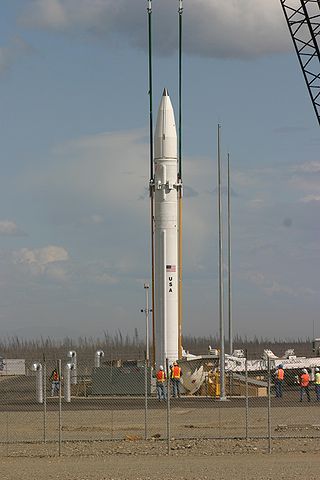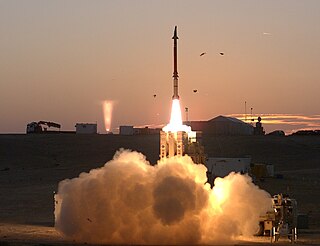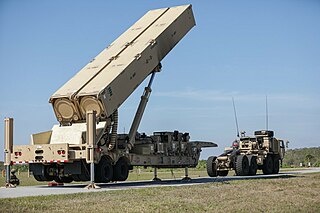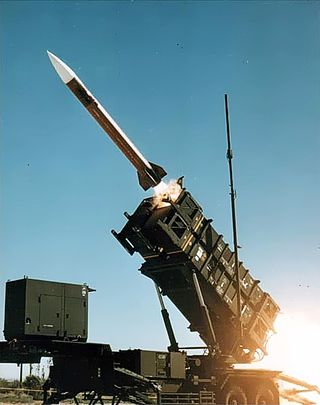Related Research Articles

An anti-ballistic missile (ABM) is a surface-to-air missile designed to counter ballistic missiles. Ballistic missiles are used to deliver nuclear, chemical, biological, or conventional warheads in a ballistic flight trajectory. The term "anti-ballistic missile" is a generic term conveying a system designed to intercept and destroy any type of ballistic threat; however, it is commonly used for systems specifically designed to counter intercontinental ballistic missiles (ICBMs).

The M142 HIMARS – M142 High Mobility Artillery Rocket System – is a light multiple rocket launcher developed in the late 1990s for the United States Army and mounted on a standard U.S. Army Family of Medium Tactical Vehicles (FMTV) M1140 truck frame.

The Aegis ballistic missile defense system, also known as Sea-Based Midcourse, is a Missile Defense Agency program under the United States Department of Defense developed to provide missile defense against short and intermediate-range ballistic missiles. The program is part of the United States national missile defense strategy and European NATO missile defense system.

The IRIS-T is a medium range infrared homing air-to-air missile available in both air-to-air and ground defence surface-to-air variants. It also is called AIM-2000.

Ground-Based Midcourse Defense (GMD) is the United States' anti-ballistic missile system for intercepting incoming warheads in space, during the midcourse phase of ballistic trajectory flight. It is a major component of the American missile defense strategy to counter ballistic missiles, including intercontinental ballistic missiles (ICBMs) carrying nuclear, chemical, biological or conventional warheads. The system is deployed in military bases in the states of Alaska and California; in 2018 comprising 44 interceptors and spanning 15 time zones with sensors on land, at sea, and in orbit. In 2019, a missile defense review requested that 20 additional ground-based interceptors be based in Alaska.

Terminal High Altitude Area Defense (THAAD), formerly Theater High Altitude Area Defense, is an American anti-ballistic missile defense system designed to shoot down short, medium, and intermediate-range ballistic missiles in their terminal phase by intercepting with a hit-to-kill approach. THAAD was developed after the experience of Iraq's Scud missile attacks during the Gulf War in 1991. The THAAD interceptor carries no warhead, instead relying on its kinetic energy of impact to destroy the incoming missile.

The Field Artillery Branch is a combat arms branch of the United States Army that is responsible for field artillery.

The AN/MPQ-64 Sentinel is an X-band electronically steered pulse-Doppler 3D radar system used to alert and cue Short Range Air Defense (SHORAD) weapons to the locations of hostile targets approaching their front line forces. It is currently produced by Raytheon Missiles & Defense.

Hypersonic flight is flight through the atmosphere below altitudes of about 90 km at speeds greater than Mach 5, a speed where dissociation of air begins to become significant and high heat loads exist. Speeds over Mach 25 have been achieved below the thermosphere as of 2020.

Iron Dome is an Israeli mobile all-weather air defense system developed by Rafael Advanced Defense Systems and Israel Aerospace Industries. The system is designed to intercept and destroy short-range rockets and artillery shells fired from distances of 4 to 70 kilometres (2–43 mi) away and whose trajectory would take them to an Israeli populated area. From 2011 to 2021, the United States contributed a total of US$1.6 billion to the Iron Dome defense system, with another US$1 billion approved by the US Congress in 2022.

The AIM-9 Sidewinder is a short-range air-to-air missile. Entering service with the United States Navy in 1956 and the Air Force in 1964, the AIM-9 is one of the oldest, cheapest, and most successful air-to-air missiles. Its latest variants remain standard equipment in most Western-aligned air forces. The Soviet K-13, a reverse-engineered copy of the AIM-9B, was also widely adopted.

David's Sling, also formerly known as Magic Wand, is an Israel Defense Forces military system being jointly developed by the Israeli defense contractor Rafael Advanced Defense Systems and the American defense contractor Raytheon. It is designed to intercept enemy planes, drones, tactical ballistic missiles, medium- to long-range rockets and cruise missiles, fired at ranges from 40 to 300 km. David's Sling is meant to replace the MIM-23 Hawk and MIM-104 Patriot in the Israeli arsenal.
Missile defense systems are a type of missile defense intended to shield a country against incoming missiles, such as intercontinental ballistic missiles (ICBMs) or other ballistic missiles. The United States, Russia, India, France, Israel, Italy, United Kingdom, China and Iran have all developed missile defense systems.

The Ground-Based Interceptor (GBI) is the anti-ballistic missile component of the United States' Ground-Based Midcourse Defense (GMD) system.
In air and missile defense (AMD), the Integrated Air-and-Missile Defense system (IAMD) is an SMDC research program to augment the aging surface-to-air missile defense systems and to provide the United States Army with a low-cost, but effective complement to kinetic energy solutions to take out air threats. Brigade level higher energy lasers are used in truck mounted systems called HELMTT. At lower levels, the Army needs to develop interceptors that don't cost more than small, unmanned aircraft systems. In early research they have successfully used 5-kilowatt lasers on a Stryker combat vehicle. The Mobile Expeditionary High-Energy Laser (MEHEL) was used at MFIX at Fort Sill, Oklahoma, in the first half of April, 2017.

The Raytheon Coyote is a small, expendable, unmanned aircraft system built by the Raytheon Company, with the capability of operating in autonomous swarms. It is launched from a sonobuoy canister with the wings deploying in early flight phase.
The Miniature Hit-to-Kill Missile (MHTK) is a small air defense missile developed by Lockheed Martin for the short range air defense (SHORAD) and Counter Rocket, Artillery, and Mortar (C-RAM). Like the Israeli Tamir and Stunner the MHTK uses hit-to-kill for the terminal phase of interception.

The Long-Range Hypersonic Weapon (LRHW) is a medium-range surface-to-surface hypersonic weapon for use by the United States Army in 2023. The United States Navy intends to procure a ship/submarine-launched variant of the missile as part of the service's Intermediate-Range Conventional Prompt Strike (IRCPS) program. The weapon consists of a large rocket booster that carries the unpowered Common-Hypersonic Glide Body (C-HGB) in a nose cone. Once the booster reaches significant altitude and speed, it releases the C-HGB, which glides at hypersonic speeds as it descends towards its target. Dynetics will build the hypersonic glide vehicle while Lockheed Martin will build the booster as well as assemble the missile and launch equipment.
Joint All-Domain Command and Control or JADC2 is the concept that the Department of Defense has developed to connect sensors from all branches of the armed forces into a § unified network powered by artificial intelligence. These branches include the Air Force, Army, Marine Corps, and Navy, as well as Space Force.

The United States Army Integrated Air and Missile Defense [IAMD] Battle Command System (IBCS) is a plug and fight network intended to let any defensive sensor feed its data to any available weapon system. The system is designed to shoot down short, medium, and intermediate range ballistic missiles in their terminal phase by intercepting with a hit-to-kill approach. IBCS has been developed since 2004, with the aim to replace Raytheon's Patriot missile (SAM) engagement control station (ECS), along with seven other forms of ABM defense command systems. In 2022, IBCS successfully completed initial operational test and evaluation (IOT&E), and was approved for full-rate production in 2023.
References
- ↑ Judson, Jen (2018-10-07). "Army nearing strategy on way ahead for Indirect Fire Protection Capability". defensenews.com. Sightline Media Group.
- 1 2 Boyd, Collins. "U.S. Army successfully fires AIM-9X missile from new interceptor launch platform". Army.mil. United States Army. Retrieved 6 November 2018.
- ↑ Tomkins, Richard. "Lockheed tests mini-missile interceptor". ups.com. United Press International. Retrieved 12 November 2018.
- 1 2 "US Army-developed multimission launcher is off the table". 15 October 2019.
- ↑ News Desk (2016-03-29). "Multi-Mission Launcher Launch a Stinger Missile on First Test". Defense Update. Defense Update. Retrieved 6 November 2018.
- ↑ Judson, Jen (2017-08-08). "Israeli Interceptor Launched From US System Destroys Target". Defense News. Retrieved 6 November 2018.
- ↑ Army Reboots Cruise Missile Defense: IFPC & Iron Dome. Breaking Defense. 11 March 2019.
- ↑ "Multi-Mission Launcher (MML)". missiledefenseadvocacy.org. Missile Defense Advocacy Alliance. Retrieved 2 August 2019.
- 1 2 Judson, Jen (4 June 2021). "Dynetics unveils Enduring Shield, its solution for the US Army to counter cruise missiles". www.defensenews.com. Defense News . Retrieved 5 June 2021.
- ↑ Osborn, Kris (2017-01-16). "The U.S. Army's New Missile Launcher Has a Super Game Changing Trick Up Its Sleeve". National Interest. National Interest. Retrieved 6 November 2018.
- ↑ Dayley, Colonel Brant. "The Future of U.S. Army Missile Defense". www.youtube.com. Center for Strategic & International Studies. Retrieved 10 December 2018.
- ↑ Judson, Jen (2019-05-16). "Dynetics-Lockheed team beats out Raytheon to build 100-kilowatt laser weapon". defensenews.com. Defense News. Retrieved 20 May 2019.
- ↑ Judson, Jen (7 August 2019). "Soon to come to the Army: A high-power microwave to take out drone swarms". www.defensenews.com. Defense News. Retrieved 8 August 2019.
- ↑ "Multi-Mission Launcher" (PDF). amrdec.army.mil. AMRDEC. Retrieved 6 November 2018.
- ↑ Howard, Courtney (September 2015). "U.S. Army engineers prep Multi-Mission Launcher prototype, designed to defeat UAS, missiles, rockets". intelligent-aerospace.com. Intelligent Aerospace. Retrieved 9 May 2019.
- ↑ Here’s who the US Army has tapped to build an enduring capability to counter drones and cruise missiles. Defense News . 24 August 2021.
- ↑ Army Wants Supersonic Cruise Missile Interceptor For Its New Air Defense System. The Drive/The War Zone. 17 January 2023.
- ↑ Army pursuit of new air and missile defense interceptors heating up. Defense News . 9 October 2023.